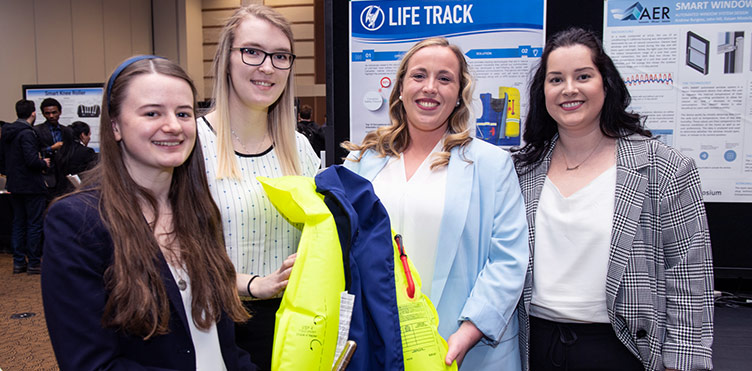
Four UNB engineering students, with close personal and working ties to the marine industry, have developed a smart life-jacket they believe could save more lives.
The LifeTrack Outlast life-jacket was designed by fourth-year engineering students Amy Andrews, Bridget McCloskey, Kaitlin MacIsaac and Phoenix Bard-Cavers through UNB’s Technology Management and Entrepreneurship (TME) program. The idea came in response to a 2017 Globe & Mail story citing the fishing industry as the deadliest industry in Canada.
“The fishing industry has the highest fatality rate of any other industry in the country,” says Bard-Cavers. “Most on-the-job deaths happen because workers aren’t wearing life-jackets, or the person who has fallen overboard is wearing a lifejacket but can’t be located.”
Shocked by this data and by the number of people losing their lives on the job, the team spoke with people in the industry, and to people in their own lives who work in the industry, to learn more. They found that workers often avoid life-vests because they hamper their ability to work quickly and efficiently.
“Our goal is to make something people want to wear,” says McCloskey. “We want to develop a lifejacket that doesn’t get in the way, that can be put on like a regular piece of clothing and forgotten about.”
With this goal in mind, the team developed the Outlast life-jacket, an automatically inflating, low-profile life vest with a built-in tracking device.
“When you enter the water, the life jacket inflates,” says Bard Cavers. “That way, when it’s deflated it isn’t getting in the way of the workers’ duties.”
The Outlast’s tracking features also kicks in when the jacket has been inflated. The distress signal can be cancelled manually by the wearer within 30 seconds if they are in a situation where they can be picked up. In emergency situations, the signal transmits to marine radio where nearby vessels or the Coast Guard will be notified.
The team says that while regulations have tightened in provinces like Nova Scotia, life jackets simply have not been keeping pace with the needs of industry workers. While tracking beacons can be purchased separately from life-jackets, the team believe that by combining the two, more lives will be saved.
“It’s just one less thing to remember in the morning,” says McCloskey.
“The LifeTrack team recognized that excessive drowning incidents point to shortcomings in current equipment and are deeply committed to act on it,” says Linda Bulmer, the team’s TME industrial mentor. “Their life-jacket design aims to expedite retrieval, save more lives, prevent family suffering and sustain maritime community livelihoods. They are true believers that lives are precious and safety priceless.”
While the Outlast was specifically designed for those working in the marine industry, Bard-Cavers says it could also be used for a variety of water-based activities. The team won first prize at this year’s annual Engineering Design Symposium and plans to continue working on the Outlast with the eventual goal of securing funding to create a functional prototype.
“We know that we can’t force anyone to wear our product,” says Bard-Cavers. “But we can try and make people’s work life safer by offering more practical options.”